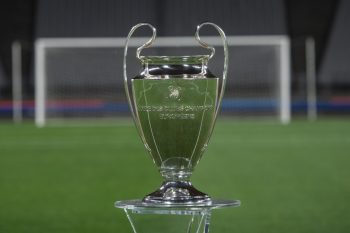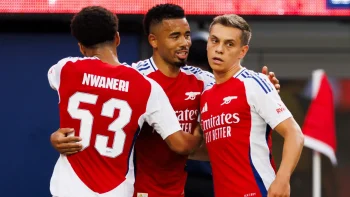Sports
How Isaiah Hartenstein And Alex Caruso Make The Thunder More Versatile On Offense

Expectations have officially jumped for the Oklahoma City Thunder. It didn’t take long at all. Just 12 months ago, most fans assumed the Thunder would be a frisky, upstart playoff team after their play-in run in 2023. They shattered that idea, winning the Western Conference in the regular season but losing in the second round to the Dallas Mavericks. Despite coming down to earth in the post-season, this summer has only helped raise those expectations further.
Enter Alex Caruso and Isaiah Hartenstein: the two significant off-season additions to this now championship-hopeful Thunder core.
On the surface, it’s easy to see what they bring to Oklahoma City: defensive versatility, depth, size, and a boost in rebounding, to name a few. Truthfully, these aspects are all crucial as the Thunder enter this season as genuine ‘contenders.’ Adding two players who were arguably both top 20 defenders last season will provide a significant boost for a team that boasted the 4th best defense.
It’s easy to see how Caruso’s active hands and strength will only heighten OKC’s knack for forcing turnovers and getting out in transition. He plays bigger for his size and, despite being 6-foot-4, can guard up and across multiple positions. It’s also easy to see how Hartenstein’s activity in the pick-and-roll and size will only bolster the Thunder’s frontcourt. Pairing him with Chet Holmgren will provide OKC with more options on the defensive end: they can put Holmgren on the weak side, where he can use his Pterodactyl-like length to block shots and have Hartenstein clean things up on the inside. Or, they can opt to go smaller and have Holmgren be the man anchoring the middle — an area he was incredibly formidable in as a rookie, becoming one of the most versatile defenders at his position in the league.
That being said… defense wasn’t the reason the Thunder lost in the playoffs to the Mavericks. Their offense—which was third in the regular season—failed them in the post-season.
How OKC’s Offense Failed Them Versus The Mavericks
In the six games versus Dallas in the West Semis, OKC’s usual 118.3 offensive rating fell to 111.3 and 110.9 throughout their ten post-season games. A drop in offensive efficiency is expected in the playoffs, but only the Nuggets (-8.3 drop off) had a worse dip offensively than the Thunder (-7.9) compared to all teams who made it to at least the second round.
OKC struggled in a few departments versus Dallas: 3-point shooting (both pull-up and off the catch), drive efficiency, and lacked diversity in their looks on any offensive possession.
First, the shooting. During the regular season, OKC was the best 3-point shooting team in the league, hitting almost 39% of their threes. In their six games against the Mavericks, they shot a woeful 33.5%. In the regular season, they knocked down over 40% of their catch-and-shoot threes. Against Dallas, 32.1%. They actually shot 40% on pull-up threes versus Dallas compared to just 34% during the regular season, but it was the lowest volume of any team in any series in the conference semi-finals.
Why? Well, the Mavericks did an excellent job of forcing the Thunder into threes they were willing to concede. Lu Dort led OKC in 3-point attempts in the series with nearly seven a game and shot a measly 32%. Holmgren was second on the team in attempts and shot 22%. Giddey, who somehow attempted nearly three a game, shot 18% before he was finally benched later in the series. All respect to those guys, but one of them is a streaky shooter, the other was a rookie, and one of them is a flat-out non-shooter.
The Thunder, in general, weren’t a high-volume 3-point shooting team all season. They ranked 16th in 3-point attempts with just under 35 per game. That being said, Dallas was able to force them to funnel the ball to certain shooters because OKC’s potent driving game was utterly shut down by the Mavericks, who swarmed with constant digs and help that made it hard for anyone other than SGA to get going. The Thunder shot 8% worse on drives against the Mavs than in the regular season. They passed out of those drives 14% more often, too, meaning fewer drives resulted in a basket. It particularly hurt Jalen Williams, who shot a brutal 36% on drives compared to 54% in the regular season. Williams had developed a potent two-man game with Holmgren, and that quickly withered away in that series, too, as his developing ballhandling failed him in a tighter post-season setting.
Without the Thunder’s drive-and-kick game, the Mavericks turned OKC into a one-trick pony on offense. And while SGA’s brilliance was enough to push Dallas to six games, they were outmatched on that side of the ball. In post-season basketball, it comes down to how malleable you are in any given situation, and when push came to shove, the Thunder weren’t versatile enough offensively.
How Hartenstein And Caruso Help On Offense
Many are quick to point out how impactful Caruso and Hartenstein will be defensively for this Thunder team — but we’re sleeping on the offense, folks. Neither player will directly change the Thunder’s shooting or driving woes against Dallas, but they score an A+ in the versatility they’ll provide.
Caruso is coming off the best shooting season of his career, knocking down nearly 41% of his threes on nearly five attempts for Chicago last season, most of them off the catch. Since joining the Bulls, his catch-and-shoot average has been about 38%, which is more than enough to keep him on the floor for his otherworldly defensive impact. That being said, much like Dort, teams will live with Caruso beating them from outside, so it’s not in this way that he makes them more versatile offensively — although it will help that he’s less streaky than Dort.
Caruso provides an incredible knack as a screener for his position and a potent feel for secondary playmaking, which will help churn the wheels of the Thunder offense when it gets caught in a funk. OKC ran more guard-to-guard screens than anyone else in the NBA last season. One of Caruso’s greatest offensive gifts is his ability to set good screens as a guard, both on and off the ball, while making decisions on the go.
Check out this video from my pal Stephen Pridegon on an action the Bulls ran last season using Caruso’s craft as a screener and connector on offense:
The Bulls have been very crafty with how they weaponize Alex Caruso & his abilities both as a screener & connector within the half-court
This was a really fun rep vs Detroit 🔊 pic.twitter.com/tzoaB853OE
— Stephen PridGeon ☯️🏁 (@StayTrueSDot3) March 3, 2023
He is extremely good at greasing the wheels of an offense just by making the right read at the right time — something the Thunder lacked outside of SGA and Giddey last season.
Excellente extra-pass en une touche d’Alex Caruso.
On parle bcp de sa défense mais autre gros apport à CHI : son passing (vision + QI + altruisme).
Pas forcément créateur balle en main/proactif d’élite mais excellent fluidificateur de jeu. Fait fructifier le décalage déjà créé. pic.twitter.com/RgyS9vLIRb
— Guillaume | Le Basket Lab (@GuillaumeBLab) November 22, 2021
Similarly, the same can be said about Hartenstein — who’s screening and short-roll playmaking prowess is going to give the Thunder an excellent change-up option to go to.
First, the screens. No one on the Thunder can set a screen like Isaiah Hartenstein. His massive frame helped him be in the top 15 in screen assists for New York last season, opening up driving lanes and crevices for Jalen Brunson to have a career year. He was fourth in screen assists in the playoffs behind Rudy Gobert, Nikola Jokic, and Bam Adebayo.
Isaiah Hartenstein is a tremendous screener in the PNR. His angling and body position provide advantages for his guards
•Wide base and active hips
•Flips the screen towards the single side
•Delays the roll to provide extra space for the ball handler pic.twitter.com/Jt48xTQIfs— Mike Shelast (@MikeShelast) September 17, 2024
This aspect of Hartenstein’s game will directly impact OKC’s already potent driving game, making it even more tenable for post-season basketball and providing a forward like Williams—who is still working to improve his ballhandling—more space and time to make decisions.
This applies off the ball, too, where, like Caruso, Hartenstein is timely, strong, and has a great feel for creating openings for his teammates.
The value of Isaiah Hartenstein’s offensive IQ and execution. This pin-in screen gives DiVincenzo the open look. No play call. Just in flow. Reading and reacting. pic.twitter.com/D6uD1Yk22H
— DJ (@DJAceNBA) May 9, 2024
On top of his unbelievable screening ability, Hartenstein’s short-roll game gives the Thunder a unique look offensively. I-Hart was in the 89th percentile for his position on short-mid-range jump shots, making 54% last season and improving that mark to 61% in the playoffs. He is a tactician in that area, and leaving him open means he’s likely putting up one of his patent push shots.
Knicks basketball won’t be on for another week, here’s 1 minute and 49 seconds of Isaiah Hartenstein floaters. pic.twitter.com/zOMJwDx7LQ
— iHartMuse (@iHartMuse_) April 15, 2024
The short-roll finishing opens up his playmaking in that area — where Hartenstein can read the floor in the middle of the defense and is a superb passer for his position. It makes him an excellent release valve for guards, especially when they get trapped above the break or when an action shifts the defense, forcing it to load up on one side. His passing ability is also why it’s tenable for him and Holmgren to be paired up offensively. Holmgren can space to the corner and cut to the dunker, and Hartenstein can make that read, among others, in the short roll.
This also makes him a good release valve for guards when they get trapped. He’s a good decision maker and this often leads to him finding open shooters, especially in situations like this where he can play 4-on-3 pic.twitter.com/VD6gSH9APG
— Ariel (@APachecoNBA) July 2, 2022
None of the things that Caruso and Hartenstein bring on the offensive end are sexy. You aren’t going to wow anybody by talking about screens and connective passing, but it’s going to be crucial to the Thunder’s success as they try and contend for a championship.
Above all else, Caruso and Hartenstein give OKC options on both ends of the floor—not just defensively. They’ll have to adapt stylistically, finding ways to morph their already potent 5-out offense to add layers that incorporate both of their latest additions. But that’s the intention behind adding these two players: to change.
And while neither player directly addresses any particular glaring offensive need, they do hit on a philosophy that broadly applies to post-season basketball:
You can’t afford to be rigid in your approach.
Versatility reigns supreme no matter how good you are in one specific area of the game. If a series forces you to play big, you have to be willing to go bigger. If smaller, then so be it. If the jumper isn’t falling, you must have multiple offensive styles just in case one fails you.
OKC learned that lesson the hard way last season and is trying to correct course by adding Caruso and Hartenstein.
How does that materialize throughout the 2024-2025 season, and what wrinkles are added by Mark Daigneault and his staff?
Well, that’s half the fun.











